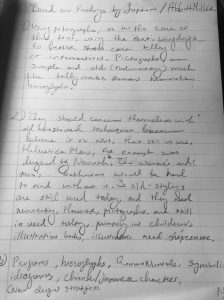To be rudimentary is to be the bare basics of a principle that structures the more advanced levels of said principle. On a general level, it is almost always important to understand the basics of something or you can never master that skill. It is impossible how to do BMX bike tricks if you can’t learn to keep your balance. You cannot program the next big video game without learning how coding works. However, Designers have a possibility of actually skipping over the rudimentary level design and still succeeding. This is because most design, nowadays, is subjective and while the structures and styles of the past can help, they are not required to make a solid design.
But that just brings up the question once again, if we don’t need the rudimentary level, why do we still need to understand it and the history behind it? As the texts discuss, design had morphed from idea to idea as time went on. When art was first conceived as an form of expression, it was considered just to be a way of the rich and wealthy to immortalize themselves forever. The idea that design was based around egocentric greed and commoners were not welcome into the more closed off and high class society. As time passes on, design took a more commercial approach and reached the major population rather than just the rich upper class. However, the text notes that while designers had the ability to be designers, they did not really think like designers. In the 50’s, designers seemingly made designs that lacked emotion, self expression, and a form of identity. In the late 60’s-70’s, the more corporate aspects of design were fading out for a more creative direction, one that gave the designer a ‘voice’ in their designs. The progression of design afterwards toward today expanded on this approach to design, adding more of a free, limitless ability to design of their choosing.
Even after all of that history lesson, the question has still not been answered. Rudimentary design and design methods of the past are important because they teach the basic foundation of design back when design was in a much simpler state. Now that we live in a society that has access to a software that makes designs on many of our devices, it becomes much more complicated to make a proper design without understanding what has structured and defined a design throughout our history. As common as the idea that everything has been done before is, it is one that is true in almost every aspect of the phrase. It is important to understand the history of design to understand what you made in relation to past styles of design. Going on the idea that no design today is completely original in principle, it is important to know the inspirations that formed your design and if your design is too similar to those inspirations. Overall, rudimentary design is important in every aspect because it is holds all the principles we learn as modern designers and structures the foundations for designs to delve into more complex structures in the future.















